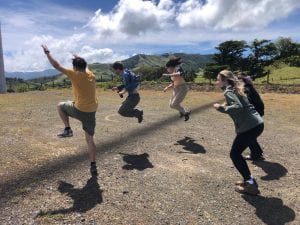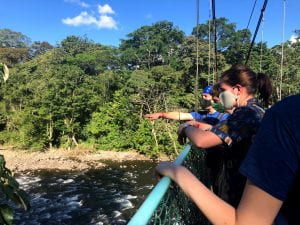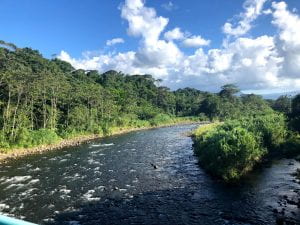We recently returned from our first field station trip to study a different Costa Rican life zone. We went to Tirimbina, which is a tropical rainforest in the Caribbean lowlands so it was much hotter and more humid than the CIEE campus. Before leaving, we asked one of our professors, Branko, about the rumors we heard about him previously being the academic director at the Tirimbina field station. He confirmed these rumors with the question, “Who told you?” On our way there, we stopped at one of the many gigantic windmills on the hills that we were driving through. One of the units for our “Humans in the Tropics” class is “Energy,” so Branko talked for a little bit about the windmills in Costa Rica. In proper TEC fashion, we finished off our mini windmill lecture by playing jump rope with the shadow from the windmill. After getting all of our energy out with the windmill-jump-rope we jumped back into the van and continued to Tirimbina.
Once we arrived at the field station, the person working in the entrance called Branko “Don Branko” which is a relatively informal, but still respectful, way of greeting people in Costa Rica. Although “Don” is a common way of addressing someone here, we found it really entertaining. Especially in combination with the fact that Branko used to be the Academic Director of that field station and everyone seemed to know him there, we made a lot of jokes about how he secretly runs the place. We saw a lot of really cool wildlife i.e. sloths, poison dart frogs, kinkajous, and toucans. Everytime we saw some cool wildlife we joked that Don Branko coordinated for it to be there. We were waiting for our breakfast to come out of the kitchen one morning and Don Branko said “this area is a really good place for spotting sloths” to which of course we joked that he was saying that very loudly into a microphone so people would bring in the sloths. Sadly, when we left the Tirimbina field station Branko’s powers disappeared.
Our other professor, Johel, is a hilarious storyteller. He has been doing fieldwork for long enough that he has seen the best and the worst field station drama, medical emergencies, terrible cafeteria food, and research gone wrong of course. The funniest story was one that we call the “gay snails” story, but I don’t have the skill to summarize that one. The wildest story was about an unidentified insect that bit him in Costa Rica the day before he flew to the U.S. where medical professionals were unfamiliar with the tropical insect bite, so it got infected and left him with a scar that he still has today. He told that story because one of the other students on the program had a bot fly in her skin that she found two weeks after it was probably delivered to her from a mosquito. She came out of the room and said, “Hey Johel, how do I tell if I have a parasite?”
We took a night hike the first night that we were there. Tirimbina has a very long suspension bridge across a wide river. It was always so magical to stand on the bridge and feel the wind, to look around at the trees and the birds, to look down at the water rushing so far below me with a mind of its own. We walked across the bridge at least a few times everyday that we were there, but it never got old. All 4 minutes that it took to walk the whole bridge were always a game of wobbly steps and admiring the view, looking for wildlife. Walking across at night for our night hike was a completely different type of magic. It was a little bit more mysterious, but also more peaceful. The stars were making themselves known that night, with a few purple clouds decorating the sky and the crescent moon hanging down like a little bowl. We saw lots of kinkajous in the trees above the bridge that night, and then we went down by the water to look for more species. We saw lots of strawberry poison dart frogs, spiders, and millipedes.




